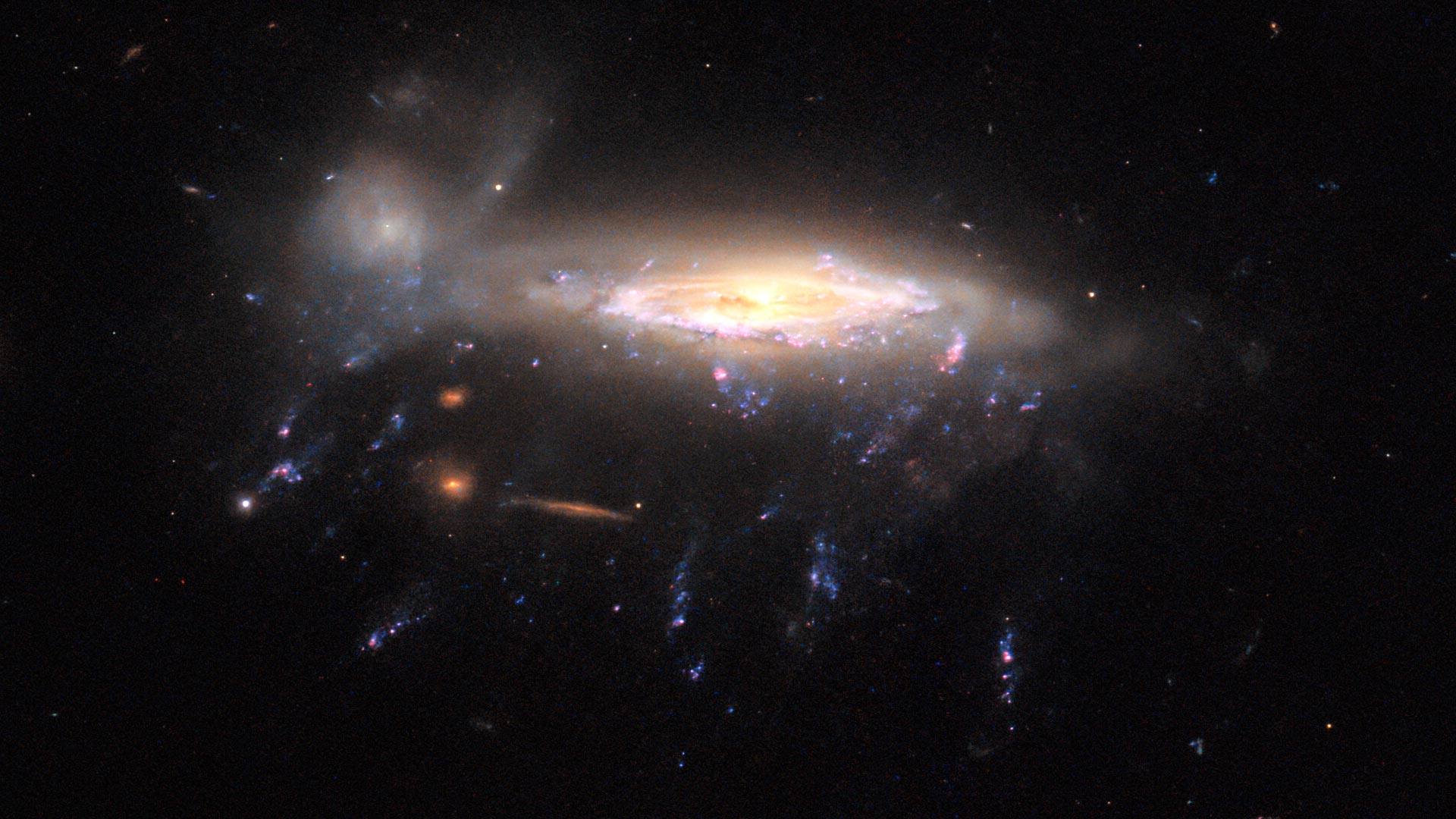
JO204, „galaktyka meduzy” znajdująca się 600 milionów lat świetlnych stąd, w gwiazdozbiorze Sextans, zawiera jasne plamy gazu przypominające macki meduzy. To zdjęcie, wykonane przez Kosmiczny Teleskop Hubble’a, jest częścią serii Zdjęć Tygodnia przedstawiających galaktyki meduzy. Galaktyki te są tyglem formowania się gwiazd w wyniku astronomicznego procesu zwanego odpędzaniem pod ciśnieniem tłoka. Gdy galaktyki poruszają się w kierunku ośrodka międzygalaktycznego, ich luźno związany gaz jest usuwany, powodując zapadanie się chłodniejszego, gęstszego gazu i tworzenie się nowych gwiazd w galaktycznych mackach. (Przycięty widok. Zobacz pełny obraz poniżej.) Źródło: ESA/Hubble i NASA, M. Gullieuszik i zespół GASP
the[{” attribute=””>Hubble Space Telescope captured an image of JO204, a “jellyfish galaxy” characterized by bright gas tendrils resembling jellyfish tentacles. These galaxies experience ram pressure stripping, which causes their loosely bound gas to collapse and form new stars in their tendrils.
Here we see JO204, a ‘jellyfish galaxy’ so named for the bright tendrils of gas that appear in this image to be drifting lazily below JO204’s bright central bulk. The galaxy lies almost 600 million light-years away in the constellation Sextans. This image was captured by the NASA/ESA Hubble Space Telescope, and it is the third of a series of Pictures of the Week featuring jellyfish galaxies. This series of images is possible thanks to a survey in which observations were made of six of these fascinating galaxies, including JO204. This survey was performed with the intention of better understanding star formation under extreme conditions.

Hubble Space Telescope image of ‘jellyfish galaxy’ JO204. Credit: ESA/Hubble & NASA, M. Gullieuszik and the GASP team
Given the dreamy appearance of this image, it would be understandable to wonder why jellyfish galaxies should be such a crucible for star formation. The answer is that — as is often the case with astronomy — first appearances can be deceiving. Whilst the delicate ribbons of gas beneath JO204 may look like floating jellyfish tentacles, they are in fact the outcome of an intense astronomical process known as ram pressure stripping.
Ram pressure is a particular type of pressure exerted on a body when it moves relative to a fluid. An intuitive example is the sensation of pressure you experience when you are standing in an intense gust of wind — the wind is a moving fluid, and your body feels pressure from it. An extension of this analogy is that your body will remain whole and coherent, but the more loosely bound things — like your hair and your clothes — will flap in the wind. The same is true for jellyfish galaxies. They experience ram pressure because of their movement against the intergalactic medium that fills the spaces between galaxies in a galaxy cluster. The galaxies experience intense pressure from that movement, and as a result their more loosely bound gas is stripped away. This gas is mostly the colder and denser gas in the galaxy — gas which, when stirred and compressed by the ram pressure, collapses and forms new stars in the jellyfish’s beautiful tendrils.
References:
“UV and Hα HST observations of 6 GASP jellyfish galaxies” by Marco Gullieuszik, Eric Giunchi, Bianca M. Poggianti, Alessia Moretti, Claudia Scarlata, Daniela Calzetti, Ariel Werle, Anita Zanella, Mario Radovich, Callum Bellhouse, Daniela Bettoni, Andrea Franchetto, Jacopo Fritz, Yara L. Jaffé, Sean McGee, Matilde Mingozzi, Alessando Omizzolo, Stephanie Tonnesen, Marc Verheijen and Benedetta Vulcani, 7 March 2023, The Astrophysical Journal.
DOI: 10.3847/1538-4357/acb59b
“HST imaging of star-forming clumps in 6 GASP ram-pressure stripped galaxies” by Eric Giunchi, Marco Gullieuszik, Bianca M. Poggianti, Alessia Moretti, Ariel Werle, Claudia Scarlata, Anita Zanella, Benedetta Vulcani and Daniela Calzetti, The Astrophysical Journal.
arXiv:2302.10615

„Analityk. Nieuleczalny nerd z bekonu. Przedsiębiorca. Oddany pisarz. Wielokrotnie nagradzany alkoholowy ninja. Subtelnie czarujący czytelnik.”



